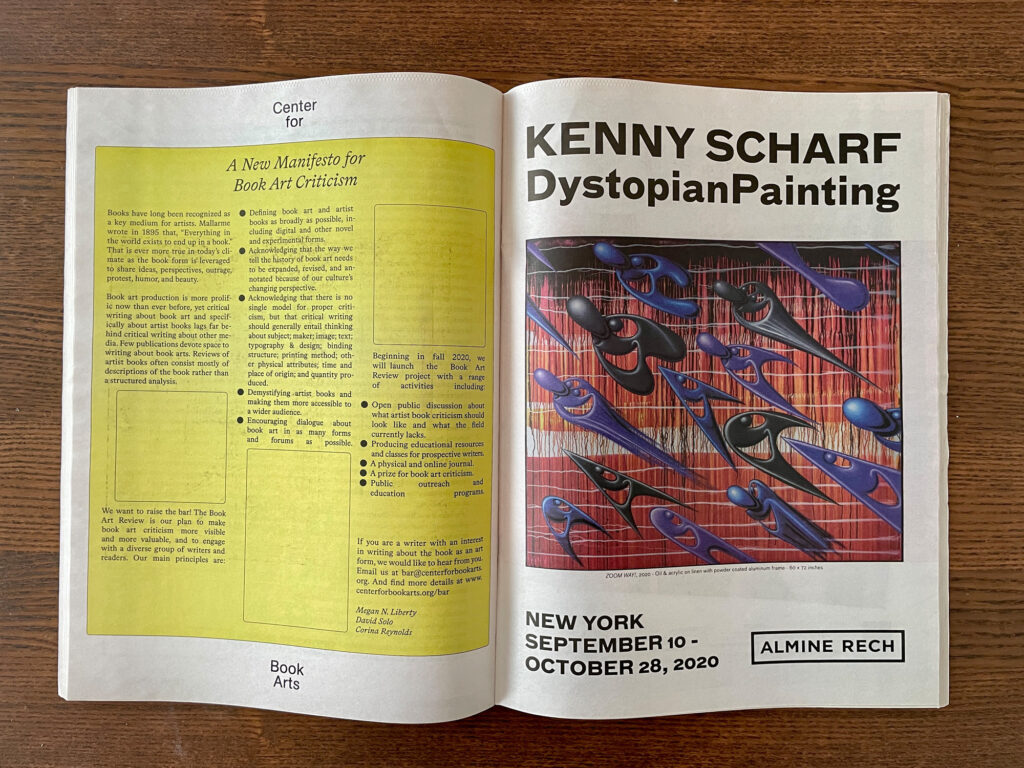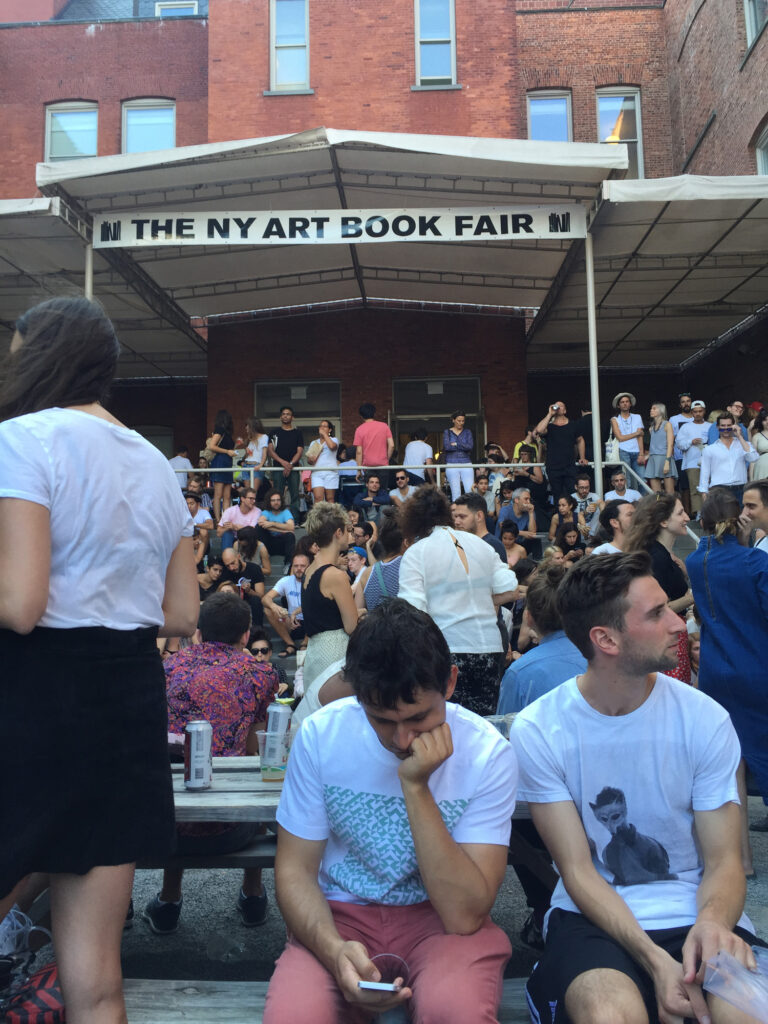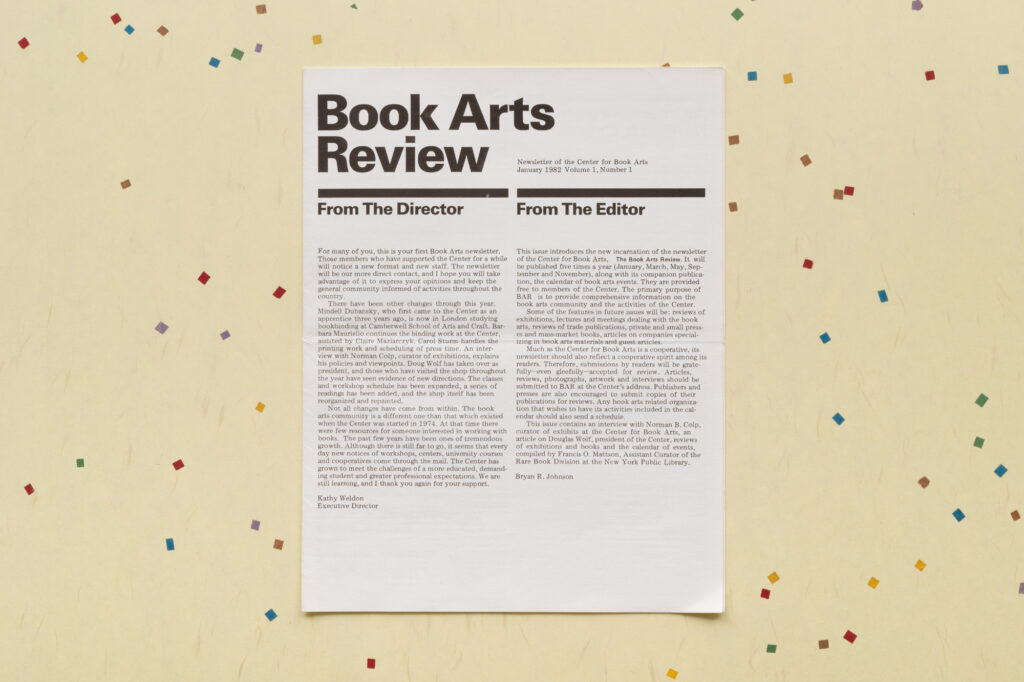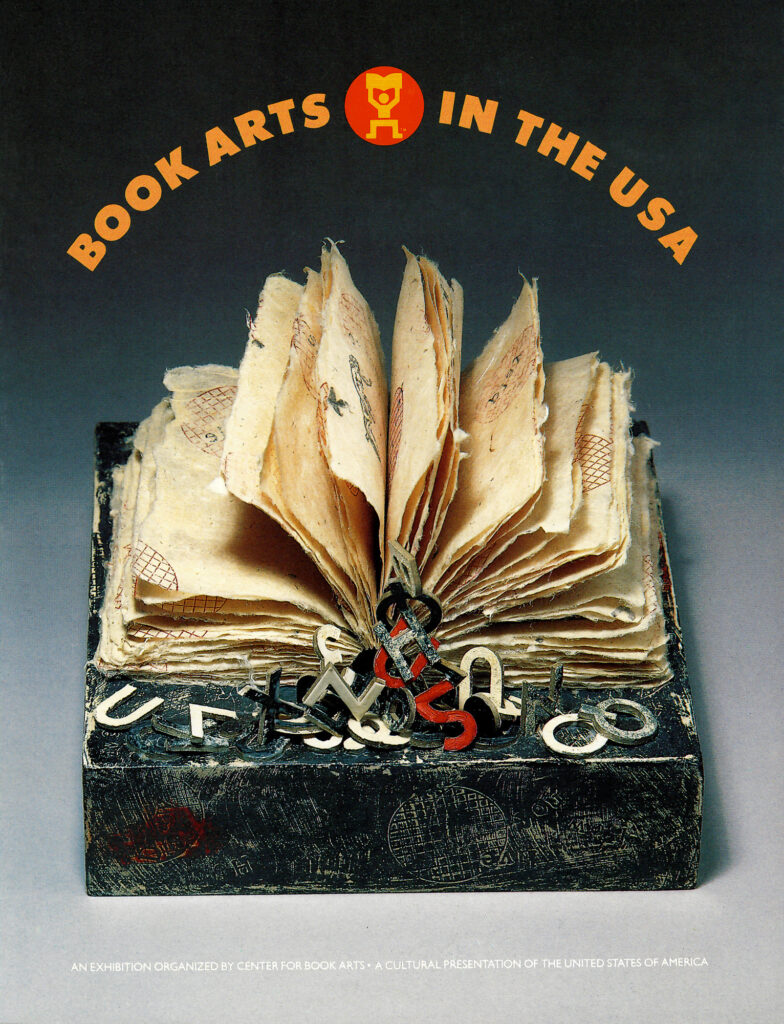The idea for Book Art Review, a criticism initiative and a magazine, came together over a set of conversations, discussions, and a few glasses starting in the fall of 2019. In 2020, BAR’s Manifesto was published in the Brooklyn Rail’s September issue and online on the CBA website. In June of 2021, Megan N. Liberty, Corina Reynolds, and David Solo—the cofounders of BAR—sat down to talk about how it came together and the concepts and goals driving the initiative.

CR: Dave, I remember talking with you during the last in-person New York Art Book Fair, September 2019. We had wandered off with heavy bags to get a beer and ended up talking about how to raise the visibility of artists’ books[1]. My initial idea was to figure out a way to convince magazines to include more writing about book art by funding columns. I really had that idea stuck in my head and so, when you asked, “Why don’t we just do a journal or magazine?”—it clicked.
DS: I hadn’t thought so much about the fair as a direct catalyst as much as wondering what happens to that audience the rest of the year. In the interim, are they attending programs that help them think about the work they are seeing? Is that one of the goals of criticism, as well as to help the audience look at work that is interesting?
ML: That’s such an important point, to consider how criticism plays into a real-time scenario in the fair space. All three of us have very different tastes and preferences for the types of artists’ books that we’re interested in. An important part of BAR is that we each bring a little bit of a different perspective to that.
CR: When you have thirty thousand to forty thousand people coming through to look at books, and there are thousands of books on tables, if the work being shown is chosen because of its social network, that’s different from being chosen because the work is compelling. A critical publication could really help to guide and inform decisions, as well—not just to diversify acquisitions by libraries, but also to create visibility for books by people who are doing really thoughtful, compelling work, but who may be unknown just because they’ve never had a table at the fair.

ML: Corina, you and I had been talking about artists’ book criticism for a while and about what I’ve been trying to do at the Brooklyn Rail to cultivate an interest with both writers and readers of artists’ books. It’s interesting that the book fair was a catalyst for criticism as a way to develop a sense of discernment for the collector. Since I never thought about it that way. I always thought about criticism as serving a community of artists and intellectuals and wanting to help artists make better work. My background is in art history, so I was thinking a lot about canonization and criticism as building an archive—who gets written about, how that writing leads to collecting by institutions, and how criticism impacts this cycle of support. I want to be able to change which kinds of artists get that support.
CR: For me, criticism is a way to expand the canon, fill in gaps, and provide exposure. By engaging with different types of work and new artists, we can give critical feedback to someone who’s producing democratic multiples and someone else who’s producing one-of-a-kind books in the same issue—and, by proximity, expose them to the work of each other.
It’s also interesting to look back at some of the early exhibition catalogues at Center for Book Arts. For example, the Book Arts in the USA (1990) catalogue includes a really diverse range of book formats—unique books, book-like sculptures, democratic multiples, and several works on the fine-print side of things.[2] Even in those early years, there was a serious effort to build representation for a really wide range of book art.
DS: When it comes to libraries and other institutions, there is a need and desire for a shopping list. It’s another role of criticism, to highlight things that should find their way into the collections.
ML: I’m reading a lot of Clive Phillpot’s early writing, and we forget now that he was writing mostly for other librarians, publishing articles about how to assess whether or not to acquire books into the collection, and how to acquire and categorize them.[3]
CR: How valuable is a promotional review? Is it simply to provide the potential for financial gain, which, let’s be honest, most artists need? But these kinds of reviews rarely ask the critical questions artists need to advance their work.
DS: It comes back to the definition of value. The promotional writing value is driving sales, and so they’re valuable to the extent that they get more people to buy a book. We are looking for value from reviewers focusing on the whole book and analyzing its contents and elements, so we’re giving feedback to artists on how to make a better book. Some of the other platforms that are publishing these reviews are asking the writers to write what the pictures look like but not to do analysis. What makes BAR different is that we reinforce to writers that we want this form of analytical writing,[4] and we recognize that there are not enough platforms out there asking for it.
ML: One of BAR’s goals is to make that food chain more visible, as you say, and make clearer to the audience of artists’ books the work that goes into them—design, publishing, printing—besides just the involvement of the artist.
DS: We want to help the audience to look or read more effectively and, hopefully, as a result, enjoy more books, because they can pick it up and say, “Oh, I kind of see what someone is doing.” One of the goals of BAR and of criticism is to enable a reader to potentially go back to things they already have and see more, since we’re supporting a new way of looking and reading, an expanded idea of literacy.
ML: I like that phrase “expanded literacy.” Even with the best writers, if they don’t have experience writing about the book as an art object, the review will be about images that seem to just float in space and texts that just exist somewhere in the book. But we want writers to be really specific: How did these things work within the format of the book? What does the book look like? Is it hardcover or softcover? Bound, unbound? That doesn’t usually occur to even the most experienced critics because we’re so trained to think of books as containers for information.

CR: Yes! Involving not only the relationship of images to text, but also the physical/material/process qualities to the ideas they express. Something that I am excited to bring to Book Art Review is the idea of making language around artists’ books and book art a little bit more accessible, trying to remove the “art speak.” So that when people who don’t necessarily have that specialized background happen upon this type of writing, they can read it, and think, “That’s so fascinating, I want to learn more.” Megan, this is something you do in your writing.
ML: When I started writing about art books, I didn’t have these terms available to me to begin with, so in some ways my writing style developed out of necessity.[5] I leaned into what I didn’t know and thought, “I know how to visually describe objects and artworks so let me just do that, and try to capture how a book functions—the experience of reading it and turning the pages.” Now I like it, and now I do know more of the terms, and I don’t really want to use them because I like the idea of just focusing on how the book functions: How do you hold it? How is the artist making use of this space? Why is it a book and how does it function as a book? And maybe pointing out the ways it doesn’t always work well as a book.
CR: Another factor that invisibly affects the quality of an artists’ book is budget. Sometimes the artist has a really good idea but can’t execute it in the quantity needed to make it financially accessible to the public. I often wonder if books like this should have been made with a different distribution method in mind so they can be allowed to achieve their full potential through material and process. Distribution doesn’t always have to be through individual ownership.
DS: The choices available working with a certain-size publisher and for an established artist in New York or London may be different from the resources and options available to books coming out of Latin America or South Asia, or even out of parts of the US or Europe. The broad impact that financial considerations have for the different communities and voices and source of books, geographically and otherwise, is an important factor in looking at the book.[6]
“We’re supporting a new way of looking and reading, an expanded idea of literacy.”
David Solo
ML: For example, how do we approach an artist’s zine practice? Does it make the most sense to write a dedicated review of a zine? Or maybe there’s another format that could better give critical attention to works with a smaller production budget.
CR: Reviewing a zine is a great idea as long as you’re thinking about why it is a zine. If someone’s making the decision for a book to be this type of casual object, it should be considered part of the message and, therefore, should be addressed in the review.
DS: At least in some contexts, zines can be sort of a trial, a way to conduct an experiment for an idea to see if it’s worth taking to the level of a book or something more finished. And so, to some extent, reviewing a zine is perhaps more about reviewing the idea and whether it’s interesting. We want to think about articulating and exploring some of these questions, such as how to look differently. For example, how do you view activist material or material with a social justice agenda, and again, do you view that the same way as something that is produced as more of an art object? We don’t want the approach to be uniform; there is no one right answer for the framework. But writers should be clear about their framework. Part of what we can do is encourage these different frameworks and make the frameworks visible.
DS: You mentioned the extent to which criticism can provide some hopefully interesting input back to artists who make books. But I think publishers really need feedback, too. Criticism could also provide some useful food for thought to other people in that food chain of designers, publishers, etc., beyond the artists themselves.
CR: It’s really important for artists to understand where they have room to grow and where the opportunities are. And, while critical reviews can be viewed in a negative light, I believe there’s a way of doing so respectfully with empathy for the artist that can be generative. I hope that that’s what will happen with BAR—that we’re able to give serious critical feedback that helps to push this art form forward.

DS: It comes back to the analytical approach. Certainly being negative about certain decisions, such as, “B and C work really well, but you could have gotten some better paper,” or pointing out that “X and Y really interfered with my experience of how the book works.” We want to push our writers to support whatever statements or judgments they make about books with very specific examples, so that someone can pick up the book and say, “Oh, I see exactly what they mean,” or, “I don’t agree.”[7]
ML: There are many times that I am looking at a book and I’m thinking about the paper quality or the smell of the ink, things like how tightly or loosely bound the pages are, is it going to fall apart when I’m reading it, and wondering: Are these intentional choices that fit the concept of the book, or is this because the artist doesn’t know how to make a book? And then, if they don’t know how to make a book, is this enough to say it’s not a successful book? Or is this part of the learning experience of saying that this is their first book? So understanding how much knowledge the artists could have about these processes is also important.
One of the challenges I was thinking about was how to solve the issue of why we write about certain kinds of artists’ books and not other kinds of artists’ books, like more expensive limited-edition books or unique books. It has a lot to do with access to review copies or access to what’s needed to spend enough time with a book to assess it as a work of art. And, what does it mean to review a book that maybe nobody can ever handle?
“How did these things work within the format of the book? [...] We’re so trained to think of books as containers for information.”
Megan N. Liberty
CR: Is there a way we can give real estate to these books and provide at least some way for people to see them, even if they can’t hold the book in their hands? Maybe give a more comprehensive view of the book online? We can make high quality videos of one-of-a-kind books so that people get an idea of the materiality. For example, as you’re turning a particularly thin, crisp page, you would hear the paper crackling in the video. That seems like a really good way to provide a space for an audience to engage with work like that.
ML: We want to encourage people to think about book art the way they think about film, performance, and poetry. Especially with criticism of poetry, it’s very intuitive to think about where the line breaks are, where the page turns are, because we’re taught that matters in poetry and that it’s intentional. Borrowing from those disciplines and trying to get people to think about books as art objects using that kind of existing framework is part of this project.
DS: Thinking about it more from the perspective of the viewer or the reader, rather than the artist. Definitely part of what we’re saying is, we want to help encourage more informed consumption and reading, encourage the reviewer to be more in that recipient role, and think about the experience and the sequencing and other things that drive the experience. When I pick the book up, here’s what the artists did to make these images or assemble them.
- (1)
There has been, and continues to be, a long debate over this term, even among BAR’s founders. CR prefers artist book(s) because it opens up the field to a more general audience by eliminating the confusion over when and where to add an apostrophe. (See the debate over this in Susan Viguers, “The Artist Book and the Sailor Suit,” College Book Art Association’s Book Art Theory, February 15, 2016, https://www.collegebookart.org/bookarttheory/3806687.) ML also prefers artist book(s) for this reason but recognizes the historical precedence and library cataloguing standard of artists’ book(s); in both cases “artist” should serve as a descriptor of the type of book and not change from singular to plural based on the number of makers. DS prefers to settle on a term—artists’ book(s) is as good as any—and focus the discussion on the book rather than the label. In the interest of clarity and consistency, going forward BAR has decided to use artists’ book(s) going forward, except in cases where the style of a cited source is preserved, or where the individual writer makes the case for a different usage.
- (2)
Book Arts in the USA. New York: Center for Book Arts. April 7–May 12, 1990. See: https://centerforbookarts.org/book-arts-in-the-usa-exhibition.
- (3)
Many of Phillpot’s writings are gathered in Clive Phillpot, Booktrek: Selected Essays on Artists’ Books, 1972–2010 (Zurich: JRP/Ringier, 2013).
- (4)
Guidelines ask writers to consider, “Why is this a book? How does it work as a book? What is your analysis, interest, or approach to this book?” as foundational questions when approaching a review or essay.
- (5)
ML: Much of my early writing on artist publishing was for Hyperallergic and the Brooklyn Rail, where some of my pieces were about Christopher Williams’s exhibition catalogues (“Christopher Williams Shakes Up the Exhibition Catalogue,” Hyperallergic.com, September 24, 2014, https://hyperallergic.com/151256/christopher-williams-shakes-up-the-exhibition-catalogue/) and Tate Shaw’s book of criticism (“Blurred Library: Essays on Artists’ Books,” Brooklyn Rail, June 2017, https://brooklynrail.org/2017/06/art_books/Blurred-Library-Essays-on-Artists-Books). Writing about Shaw’s criticism showed me that prioritizing the physical reading experience of the reader could be a method of approaching criticism.
- (6)
DS: One of the questions we want to engage is how to reflect the options available to the maker in the criticism, for example, how to contrast books made with very different budgets and/or tools.
- (7)
DS: It would be great to see debates about artists’ book choices akin to debates about decisions made in films or television.
Claudia de la torre
This is a great and much needed initiative. Thanks for your efforts!
Corina Reynolds
Thanks Claudia! Feel free to pitch us any time—would be great to have your perspective in future issues!